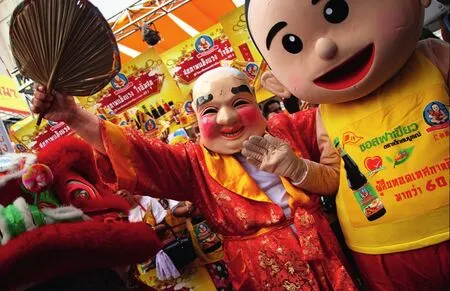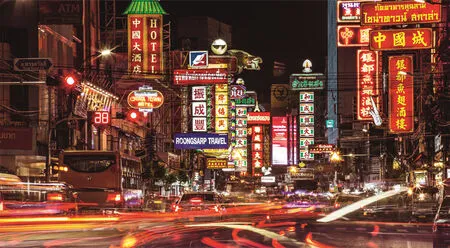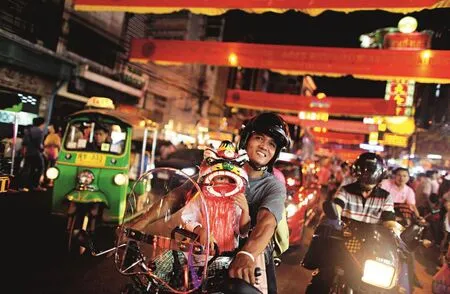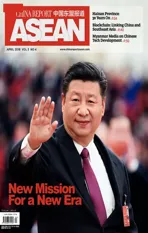TRACING CHINESE LEGACY
2018-04-14ByZhangHongrui
By Zhang Hongrui
Thailand is one of the most popular travel destinations in the world, and for visitors to Bangkok, the Thai capital’s Chinatown is an experience not to miss. Featuring wellpreserved typical Chinatown streets with rich Chinese cultural elements that have accompanied the lives and career development of Chinese immigrants, the community embodies important contributions that overseas Chinese people have made in fueling local social progress while strengthening friendship between the two countries.
A Timeless Culture
The most bustling Chinatown in Southeast Asia with a history of nearly 200 years, Bangkok’s Chinatown surrounds one major street (Sampeng) and three roads(Yaowarat, Charoenkrung and Song Wat). Locals inhabiting the area frequently speak Chinese dialects such as Teochew, Hakka and Cantonese.
As early as the reign of King Rama I (1782–1809), the Thonburi area on the western banks of the Chao Phraya River began welcoming the arrival of immigrants from China’s Guangdong. When the king relocated the capital from Thonburi to Bangkok on the eastern side of the Chao Phraya River, he designated a strip of land in Bangkok as the new settlement for Chinese immigrants. Back then, the area was relatively untouched and overrun with weeds, marshes and mud ponds. Thanks to Chinese immigrants’ efforts in land reclamation and road building over the many years that followed, the area gradually grew into a thriving community. During the reign of King Rama III (1824-1851), a surge of immigrants flooded in,and the community continued expanding to eventually form what is now known as Chinatown.

Characters representing Taoist gods on a street in Bangkok’s Chinatown during the opening ceremony of the Chinese Vegetarian Festival on September 24,2014.

Yaowarat Road, Chinatown Bangkok.

Celebrating Chinese New Year in Bangkok’s Chinatown on February 9,2013.
Yaowarat Road is the main artery of Chinatown Bangkok.Its construction began during the reign of King Rama V(1868-1910) and was not fully completed until 1900. Yaowarat Road peaked in the early 20th Century, during which time more than a thousand Chineseowned shops lined the less-thantwo-kilometer lane, making it the most popular high-end commercial and entertainment center in Bangkok at the time.Today, a stroll down this centuryold, neon-illuminated road will whisk visitors back to a bustling 1960s commercial street in Hong Kong.
Although it’s no longer the most dynamic commercial district in Thailand, Chinatown Bangkok has maintained distinctive appeal. More than a hundred gold shops, almost 70 percent of the city’s total,are found there, earning it the nickname “Gold Street.” Another signature feature of Yaowarat Road is the food. Various Chinese restaurants offering Cantonese,Hakka and Teochew cuisines collectively create a haven for foodies. Tourists can also explore savory Teochew snacks at streetside stalls as well as diverse foods that fuse Chinese and Thai cuisines. Many of the shops along Yaowarat Road are graced with portraits of Chinese gods of happiness, fortune and longevity as well as Chinese couplets with sayings on traditional moral values. During Chinese New Year, Lantern Festival, Mid-Autumn Festival and other traditional Chinese festivals,a dazzling array of decorated lanterns and vibrant lion dances add a cheerful, festive vibe to Chinatown.
Various Chinese restaurants offering Cantonese, Hakka and Teochew cuisines collectively create a haven for foodies.Tourists can also explore savory Teochew snacks at streetside stalls as well as diverse foods that fuse Chinese and Thai cuisines.
An Eternal Friendship
According to a survey of random Bangkok residents published by Bangkok Post,the majority of respondents of Chinese descent are passing on traditional Chinese culture and folk customs, especially the Chinese language, while at the same time making efforts to fit in with local society. This mirrors a shared wish of the Thai-Chinese to preserve their native culture in multi-ethnic Thai society.
Today, alongside its commercial functions, the old Chinatown also plays an active role in boosting cultural exchange and deepening friendship between China and Thailand. This February, “Happy Chinese New Year” celebrations took place on Yaowarat Road and filled every corner with typical Chinese cultural icons such as red lanterns, traditional opera facial masks, dragon dances and lion dances. Distinguished guests at the opening ceremony included Thai Crown Princess Maha Chakri Sirindhorn and Prime Minister Prayut Chano-cha. The Princess also tasted food from China’s Zhejiang Province and offered New Year wishes to the public.
This was not the Princess’s first attendance at such activities. Every year during the Chinese New Year, members of the Thai royal family and government officials show up in Chinatown for the occasion and to share the joy with the community. By doing so, they hope that the cultural event will help enhance friendship between the two peoples and fuel the development of tourism.
Chinatown Bangkok has been patronized by kings and prominent royal family members of Thailand three times. The first royal visit was made by King Rama V,who presented a cassock to the Buddhist temple in the community and met with local Chinese residents as well. In 1946, King Rama VIII took along his younger brother (later King Rama IX) on an inspection tour of the place. In 1982, Princess Maha Chakri Sirindhorn,the second daughter of King Bhumibol Adulyadej, inspected the Chinatown, which led to an unprecedented occasion.Greeted by hundred-thousandstrong cheerful crowds, the Princess spent more than two hours on the main stretch of the street to travel a mere 700 meters. Many shops flanking the street displayed greeting couplets to welcome the Princess and celebrate Sino-Thai friendship.
The Thai government has also established a museum on Yaowarat Road to honor the history of Chinese immigrants and their significant contributions to the country’s economic and cultural development.
